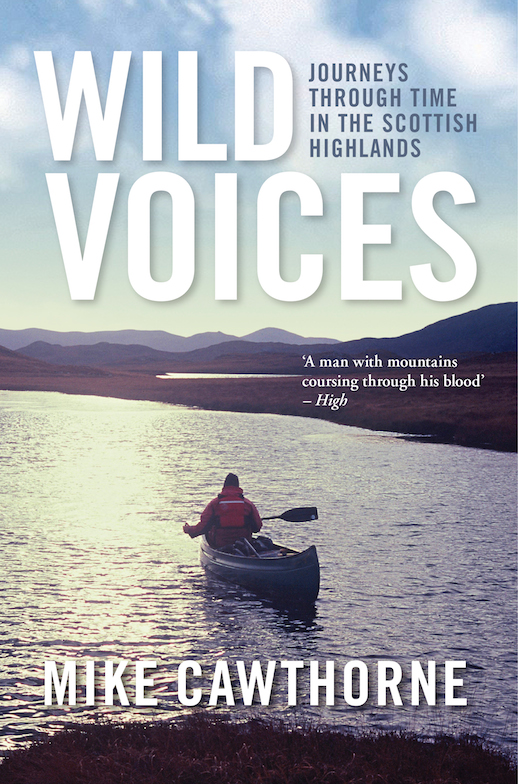Mike Cawthorne; Wild Voices: Journeys Through Time
Birlinn Limited, paperback, 220 pages
Review by Ross Macfarlane
Mike Cawthorne’s Wild Voices: Journeys Through Time in the Scottish Highlands is as much influenced by Scottish literature as Scottish landscapes. Taking as his inspiration a range of writers associated with the Highlands, Cawthorne clambers, climbs and canoes his way across some of Scotland’s most dramatic and least populated places. ranging from the River Findhorn on the north east coast to the Outer Hebrides out in the Atlantic.
Cawthorne writes in his introduction: “…in order to understand a writer of the outdoors you need to get to the places they went, stalk their shadow and for a while follow their boot-steps. You must make some attempt to inhabit their world”. Such a “walking-in-their-footsteps” book is, of course, no new idea, so why are Cawthorne’s treks worthy of your attention? Firstly, the writers he’s following are deserved of rediscovery. Whilst Wild Voices in its themes and settings echoes many writers favoured by Caught by the River – such as Robert MacFarlane, Andrew Grieg and even Roger Deakin – his actual focus is on some who have so far evaded our attention; writers like Neil Gunn, Iain Thomson and Alasdair Maclean.
Whilst aiming to capture the power of the landscapes he moves through – whether clambering up the overgrown sides of the River Findhorn, canoeing (then portaging) through the loch system of the Isle of Lewis or ascending through the Cairngorms – Cawthorne is a clear-eyed and honest writer, always aware of the dangers of personification when describing the land and nervous at times in not doing justice to the writers’ whose traces he’s following. Through the book he admits to the struggles he has in finding the right balance of words to describe the conditions he encounters. As he writes in his introduction: “Probably the great conundrum of outdoor writing, maybe any writing, is to bridge the gulf between what we see and feel and what we are able to capture on the page and present to the world”.
Cawthorne is similarly clear-eyed on the politics of landscape. As he points out, the landscapes he’s moving through are often man-made wildernesses. Described in these pages are the flooding of villages in Strathmore to make way for hydro-electric dams and also the attempt to build a super-quarry on the Isle of Harris. Whilst environment and ecology are never far from this book’s surface, emotions are held in check. Cawthorne is even honest enough to relate his conflicted attitude to wind farms: “Like many who love wild places I am torn on the issue of wind farms. To do our bit to moderate the effects of global warming probably requires the expansion of this form of energy, yet I am saddened when our dwindling portions of wildland are used for this purpose”. There’s a similar confliction to the actual journeys he makes – is there a downside to journeying through these landscapes? Should some of them be left free of man? Here he is replying to a friend on why building a footbridge might not be for the best in crossing a remote river: “If you build a bridge, you have to maintain it, then make a track to reach the bridge, and so it goes on. Why tame this place? For me the fact there are no bridges is the whole point of it”.
Cawthorne’s refusal to give into sentimentality makes certain sections all the more remarkable. For instance, he describes a ruined bothy in the Cairngorms that once had frescos painted on its walls in the mid-19th century by Edwin Landseer – a remarkable detail that Cawthorne has described and moved on from in only twenty lines (other writers would have taken chapters’ worth of detail in aiming to recreate it). Similarly, at the heart of the book lies a beautiful recollection of a book-lined bothy in the middle of Sutherland: a perfect and peaceful haven created over decades, now also desolate and ruined, but made all the more alluring for the brevity of Cawthorne’s description.
This lack of sentimentality is perfect for the book’s last journey, describing a climb in the Cairngorms in honour of the hill walker, author and poet Syd Scroggie. During the Second World War, Scroggie was blinded and lost a leg but would make hundreds of ascents in the Highlands until his death in 2006. Cawthorne knew Scroggie and his account of his life and his experiences of the Cairngorms makes for a fascinating comparison with the themes of Nan Shepherd’s rediscovered The Living Mountain. Scroggie’s own take on what he found in the Cairngorms being an “…inner experience, something psychological, something poetic, which perhaps cannot be fully understood when the physical aspect of things gets in the way”.
Cawthorne is a vastly experienced climber and walker and in Kathleen Jamie’s words is “a marvellously evocative writer; never dull, he even describes the cold with warmth”. At the time of year when thoughts turn to recollections and rememberings, here he is during a walk through Ardnamurchan, one of the most remote parts of the British Isles:
“We gave up on conversation… Wave sounds ran along the shore and in the trees there was a soft thrash of wind, but it was the acoustic of rain that eclipsed all thoughts and carried me to moments ill-remembered, though lingering on in some twilight child memory, of places and camps uprooted from different times that overlapped and came together in a kind of longing”.
Wild Voices is worthy of a place on your book shelf alongside more heralded writers of landscape, as it achieves a number of things. Once you’ve finished the last page, you’ll want to read the writers it goes in search of. Not only that, you’ll also want to visit for yourself the landscapes it describes. However, if you actually do, it will definitely make you consider the impressions and traces you’ll leave behind.
